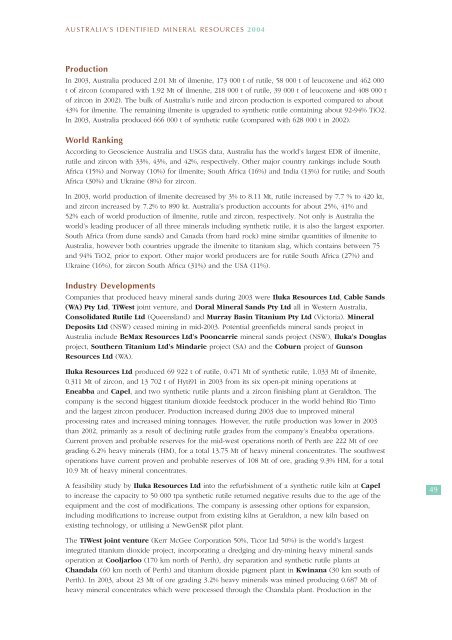australia's identified mineral resources 2004 - Geoscience Australia
australia's identified mineral resources 2004 - Geoscience Australia
australia's identified mineral resources 2004 - Geoscience Australia
Create successful ePaper yourself
Turn your PDF publications into a flip-book with our unique Google optimized e-Paper software.
AUSTRALIA’S IDENTIFIED MINERAL RESOURCES <strong>2004</strong><br />
Production<br />
In 2003, <strong>Australia</strong> produced 2.01 Mt of ilmenite, 173 000 t of rutile, 58 000 t of leucoxene and 462 000<br />
t of zircon (compared with 1.92 Mt of ilmenite, 218 000 t of rutile, 39 000 t of leucoxene and 408 000 t<br />
of zircon in 2002). The bulk of <strong>Australia</strong>’s rutile and zircon production is exported compared to about<br />
43% for ilmenite. The remaining ilmenite is upgraded to synthetic rutile containing about 92-94% TiO2.<br />
In 2003, <strong>Australia</strong> produced 666 000 t of synthetic rutile (compared with 628 000 t in 2002).<br />
World Ranking<br />
According to <strong>Geoscience</strong> <strong>Australia</strong> and USGS data, <strong>Australia</strong> has the world’s largest EDR of ilmenite,<br />
rutile and zircon with 33%, 43%, and 42%, respectively. Other major country rankings include South<br />
Africa (15%) and Norway (10%) for ilmenite; South Africa (16%) and India (13%) for rutile; and South<br />
Africa (30%) and Ukraine (8%) for zircon.<br />
In 2003, world production of ilmenite decreased by 3% to 8.11 Mt, rutile increased by 7.7 % to 420 kt,<br />
and zircon increased by 7.2% to 890 kt. <strong>Australia</strong>’s production accounts for about 25%, 41% and<br />
52% each of world production of ilmenite, rutile and zircon, respectively. Not only is <strong>Australia</strong> the<br />
world’s leading producer of all three <strong>mineral</strong>s including synthetic rutile, it is also the largest exporter.<br />
South Africa (from dune sands) and Canada (from hard rock) mine similar quantities of ilmenite to<br />
<strong>Australia</strong>, however both countries upgrade the ilmenite to titanium slag, which contains between 75<br />
and 94% TiO2, prior to export. Other major world producers are for rutile South Africa (27%) and<br />
Ukraine (16%), for zircon South Africa (31%) and the USA (11%).<br />
Industry Developments<br />
Companies that produced heavy <strong>mineral</strong> sands during 2003 were Iluka Resources Ltd, Cable Sands<br />
(WA) Pty Ltd, TiWest joint venture, and Doral Mineral Sands Pty Ltd all in Western <strong>Australia</strong>,<br />
Consolidated Rutile Ltd (Queensland) and Murray Basin Titanium Pty Ltd (Victoria). Mineral<br />
Deposits Ltd (NSW) ceased mining in mid-2003. Potential greenfields <strong>mineral</strong> sands project in<br />
<strong>Australia</strong> include BeMax Resources Ltd’s Pooncarrie <strong>mineral</strong> sands project (NSW), Iluka’s Douglas<br />
project, Southern Titanium Ltd’s Mindarie project (SA) and the Coburn project of Gunson<br />
Resources Ltd (WA).<br />
Iluka Resources Ltd produced 69 922 t of rutile, 0.471 Mt of synthetic rutile, 1.033 Mt of ilmenite,<br />
0.311 Mt of zircon, and 13 702 t of Hyti91 in 2003 from its six open-pit mining operations at<br />
Eneabba and Capel, and two synthetic rutile plants and a zircon finishing plant at Geraldton. The<br />
company is the second biggest titanium dioxide feedstock producer in the world behind Rio Tinto<br />
and the largest zircon producer. Production increased during 2003 due to improved <strong>mineral</strong><br />
processing rates and increased mining tonnages. However, the rutile production was lower in 2003<br />
than 2002, primarily as a result of declining rutile grades from the company’s Eneabba operations.<br />
Current proven and probable reserves for the mid-west operations north of Perth are 222 Mt of ore<br />
grading 6.2% heavy <strong>mineral</strong>s (HM), for a total 13.75 Mt of heavy <strong>mineral</strong> concentrates. The southwest<br />
operations have current proven and probable reserves of 108 Mt of ore, grading 9.3% HM, for a total<br />
10.9 Mt of heavy <strong>mineral</strong> concentrates.<br />
A feasibility study by Iluka Resources Ltd into the refurbishment of a synthetic rutile kiln at Capel<br />
to increase the capacity to 50 000 tpa synthetic rutile returned negative results due to the age of the<br />
equipment and the cost of modifications. The company is assessing other options for expansion,<br />
including modifications to increase output from existing kilns at Geraldton, a new kiln based on<br />
existing technology, or utilising a NewGenSR pilot plant.<br />
49<br />
The TiWest joint venture (Kerr McGee Corporation 50%, Ticor Ltd 50%) is the world’s largest<br />
integrated titanium dioxide project, incorporating a dredging and dry-mining heavy <strong>mineral</strong> sands<br />
operation at Cooljarloo (170 km north of Perth), dry separation and synthetic rutile plants at<br />
Chandala (60 km north of Perth) and titanium dioxide pigment plant in Kwinana (30 km south of<br />
Perth). In 2003, about 23 Mt of ore grading 3.2% heavy <strong>mineral</strong>s was mined producing 0.687 Mt of<br />
heavy <strong>mineral</strong> concentrates which were processed through the Chandala plant. Production in the

















